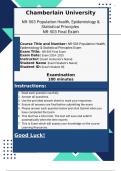Chamberlain University
NR- 503 Population Health, Epidemiology &
Statistical Principles
NR- 503 Final Exam
Course Title and Number: NR-503 Population Health,
Epidemiology & Statistical Principles Exam
Exam Title: NR-503 Final Exam
Exam Date: Exam 2024- 2025
Instructor: [Insert Instructor’s Name]
Student Name: [Insert Student’s Name]
Student ID: [Insert Student ID]
Examination
180 minutes
Instructions:
1. Read each question carefully.
2. Answer all questions.
3. Use the provided answer sheet to mark your responses.
4. Ensure all answers are final before submitting the exam.
5. Please answer each question below and click Submit when you
have completed the Exam.
6. This test has a time limit, The test will save and submit
automatically when the time expires
7. This is Exam which will assess your knowledge on the course
Learning Resources.
Good Luck!
,NR-503 Population Health, Epidemiology & Statistical Principles
2024-2025
NR-503 Week 5-8 Final Exam Study Guide Review Questions and
Answers | 100% Pass Guaranteed | Graded A+ |
Read All Instructions Carefully and Answer All the
Questions Correctly Good Luck: -
Week 5: I
In Week 5 you completed your Infectious Disease paper. Are you able to define and apply the
epidemiological triad and the HP2020 social determinants of health? How might you use those in your
Week 6 paper? The determinants of health, from social to environmental from policy to individual behavior
are critical elements to consider related to population health and the role of the
NP. Also, in Week 5, the Open Forum gave you opportunity to
‘;
review culture, access to care, and how provider attitudes impact quality of care provision.
Did you take the self-assessment? Was it informative? Social justice theory is connected to the entire NR503 course, and
also to this module, the Kleinman Explanatory Model. Had you heard of this before? Do you think the explanatory
model would be useful in trying to understand various group’s notions of health?
The 5W's of descriptive epidemiology:
What = health issue of concern
Who = person
Where = place
When = time
Why/how = causes, risk factors, modes of transmission
Weekly Objectives:
1. Discriminate populations at risk for development of chronic health conditions while associating the
role of the Advanced Practice Nurse in levels of promotion.
2. Compare and contrast variables that differentiate those categorized at being at risk for
marginalization of health care.
At the end of this week, can you answer/discuss the following: (Self-quiz)
1. How does culture influence the decisions a provider may make when selecting an
intervention?
, 2. Explain how culture impacts provider attitudes? Does it? How will you assess your own
attitudes about various cultures/races/groups?
3. Review the terms for this week and apply them to population health; for instance: cultural
competence, cultural awareness, norms, values, Kleinman Explanatory Model, socioeconomic
status, disparities, minorities, food dessert.
4. What are the social determinants of health? How does a provider integrate knowledge of
these social determinants of health into their practice? Why are they important?
5. Apply social justice theory to the provision of care; what does social justice mean when
applied to health care?
6. What data sources are used to assess determinants of health?
Discriminate Ipopulations Iat Irisk Ifor Idevelopment Iof Ichronic Ihealth Iconditions
Iwhile Iassociating Ithe Irole Iof Ithe IAdvanced IPractice INurse IinlevelsI Iof
Ipromotion.
Minorities Iand Ipeople Iwith Ilow Isocio-economic Iconditions Iare Iat Ihigher Irisk Ifor Ichronic Iillness.
TheI IAPN Ishould Ipractice Iwith Icultural Icompetence Iin Iorder Ito Iprovide Icare Ifor Ithese Ipatients.
IAsking
questionsI Iand Iresearching Ito Iknow Ihow Ieach Ipatient Iperceives Itheir Iillness Iand Ihow Ithey Iwould
Ilike Ito Itreat Iit.
Compare Iand Icontrast Ivariables Ithat Idifferentiate Ithose Icategorized Iat
beingI Iat Irisk Ifor Imarginalization Iof Ihealth Icare.
Variable Ithat Idifferentiate Ithose Icategorized Ias Ihigh-risk Ihealth Iliteracy, Icultural Ibarriers, IandlowI
IEnglish Iproficiency
1. How Idoes Iculture Iinfluence Ithe Idecisions Ia Iprovider Imay Imake Iwhen Iselecting Ian Iintervention?
The Ivery Iessence Iof Iwhat Ihealth Iand Idisease Idenotes Ican Ivary Ifrom Iculture Ito Iculture. ITherefore, Ithere Iis Ia
Iwide
spectrumI Iof Iwhat Iare Iconsidered Iappropriate Iinterventions, Iwhich Imay Inot Ibe Icompatible Iwith IWestern
Imedicine. IBased Ion Ithe Icultures' Iperceptions Iof Idisease Icausation, Isymptomatology, Iand Ipathology,
Iappropriate
interventionsI Imay Idiverge Ifrom IWestern Imedicine's Iapproach.
In Iorder Ito Iprovide Iappropriate Ihealthcare Iinterventions, Iculture Iand Iall Iits Ivariants Imust Ibe Iaddressed
I(communication, Ispace, Itime, Ienvironment, Ietc). IThe IAPN Imust Ibe Icognizant Iof Ihis Ior Iher Iown Icultural
Ibeliefs
andI Ithe Iattitudes Ihe/she Iinherently Ihas Iabout Iother Icultures.
Patients Iculture Imust Ibe Iaddressed Iwhen Iproviding Icare Ifor Ipatients. IGood Icommunication Ibetween
providerI Iand Ipatient Ibridges Ithe Igap Iand Iprovides Iculturally Icompetent Icare.
2. Explain Ihow Iculture Iimpacts Iprovider Iattitudes? I Does Iit? I How Iwill Iyou Iassess Iyour Iown
IattitudesaboutI Ivarious Icultures/races/groups?




